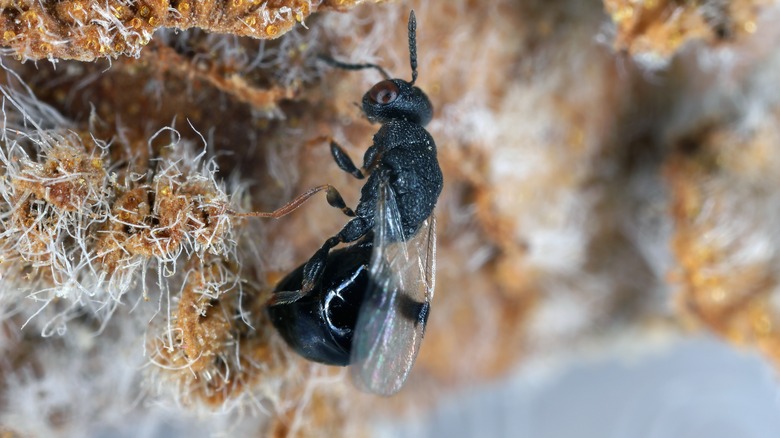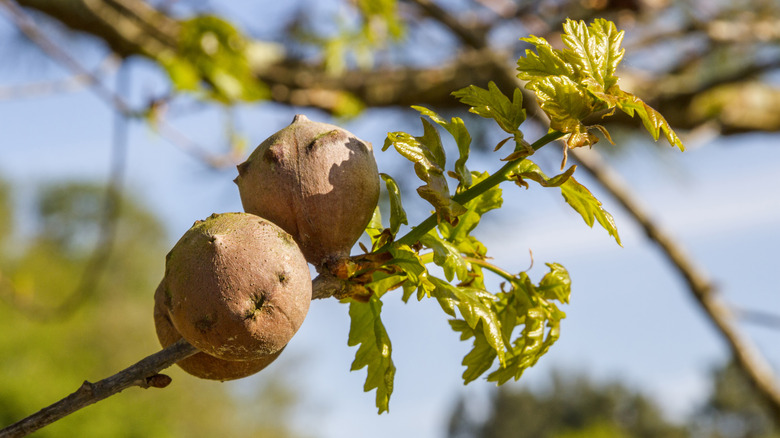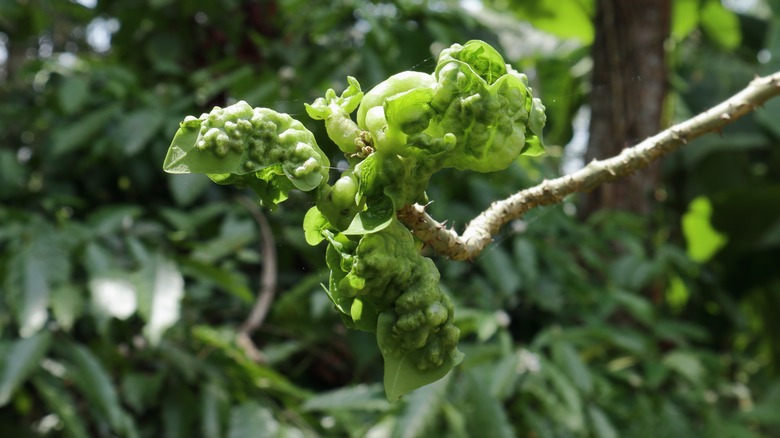Why You Shouldn't Be Alarmed When Finding Gall Wasps In Your Yard
If it's large and buzzing around our heads, our reptilian brains tell us, "RUN!" Human instincts aren't wrong here, but they do spread a little too broadly over types of wasps. Not all wasp-shaped insects can do us harm. Gall wasps are a stingless species that create galls on trees and bushes where they grow from larvae into adulthood. So, now we know they won't hurt us, but are those bulbous tumor-like balls on our trees and bushes spelling their doom?
We usually want to get rid of pesky wasps, but gall wasps are nearly as innocuous to plants as they are to animals. Yet, there is one sneaky species that's made itself unwelcome in a few of the warmer reaches of the United States. Unless you live in Hawaii or Florida, you have essentially nothing to worry about when you see gall wasps, either flying or feasting inside galls on your property.
What are gall wasps doing to your plants?
Have you seen galls on your trees and wondered, "What are they, and should they be removed?" Your yard is most likely playing host to gall wasps, and you can leave those orbs alone. Gall wasps are parasites, but only in the sense that they feed on branches or stems of oaks, roses, thimbleberries, some types of maple, and a few other plant species.
There are a few kinds of insects that make galls, but most of the ones you'll find are gall wasps. While the galls can be unsightly, there's no need to remove them unless they are particularly large. There have been cases of irregularly-shaped, oversized galls killing trees, but this is fairly uncommon.
What look like little bubbles on your plant's stems and leaves are impressive little homes made by gall wasp larvae. Females lay eggs on the leaves or branches, and once the eggs hatch, the larvae begin to eat the plant it's on. The junior bugs have a compound in their saliva that irritates the plant they're eating, and the plant reacts by growing tissue around the larvae. Unbeknownst to the plant, it's created a protective nest and kitchen for the larva that protects its vulnerable form as it eats its way to adulthood. When it's ready, the wasp will tunnel out of the gall, ready for its next step in life.
However, there is an exception
Hawaii and Florida are dreamy vacation spots for snow-weary northerners, and apparently these two states are equally attractive to another not-so-harmless gall-building wasp. Erythrina gall wasps made their American debut in Hawaii, where they quickly earned the title of "invasive species" as they spread to each and every island in the archipelago. These types of gall wasps have decimated the populations of the native wiliwili, or Hawaiian coral tree, one of the most unique trees found in the United States. Scientists are scrambling to put a halt to any more damage these bugs cause, and are having some success.
There have been sightings of erythrina gall wasps in southern Florida as well as a significant stretch of the state's east coast. These wasps feed on coral trees that grow in many southern states, southern coastal California, as well as Mexico. The USDA recommends keeping watch for signs of this wasp. If you think you see evidence of erythrina gall wasps in your area, contact the U.S. Department of the Interior to let them know exactly where you spotted the galls.


